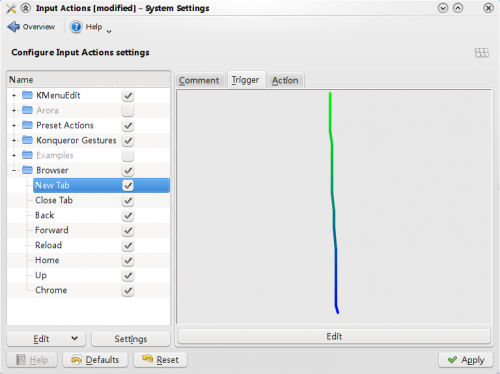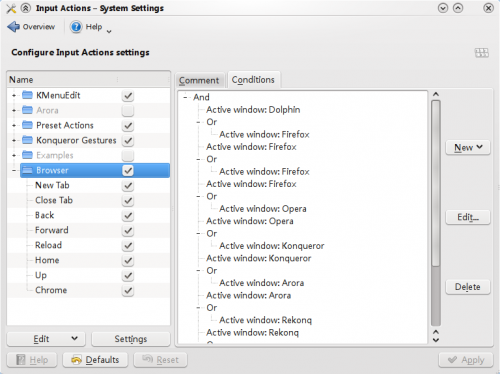Browser Configuration/Mousegestures for all Browsers: Difference between revisions
(correct typo) |
(Marked this version for translation) |
||
| Line 1: | Line 1: | ||
<languages /> | <languages /> | ||
<translate> | <translate> | ||
==Mousegestures for all Browsers== | ==Mousegestures for all Browsers== <!--T:1--> | ||
<!--T:2--> | |||
Have you never used mousegestures? Read [http://en.wikipedia.org/wiki/Mouse_gesture Mousegestures] for all Browsers to learn more. | Have you never used mousegestures? Read [http://en.wikipedia.org/wiki/Mouse_gesture Mousegestures] for all Browsers to learn more. | ||
===Step One - download the gestures file=== | ===Step One - download the gestures file=== <!--T:3--> | ||
<!--T:4--> | |||
Click [http://www.kde-apps.org/content/show.php/Mousegestures+for+all+Browsers?content=109576 here] to download browsergestures.khotkeys file.(requires KDE SC 4.3 or later) | Click [http://www.kde-apps.org/content/show.php/Mousegestures+for+all+Browsers?content=109576 here] to download browsergestures.khotkeys file.(requires KDE SC 4.3 or later) | ||
<!--T:5--> | |||
Currently supported applications: | Currently supported applications: | ||
<!--T:6--> | |||
* Konqueror | * Konqueror | ||
* Firefox | * Firefox | ||
| Line 21: | Line 25: | ||
* Kontact | * Kontact | ||
===Step Two - Import the downloaded file=== | ===Step Two - Import the downloaded file=== <!--T:7--> | ||
<!--T:8--> | |||
Import the file you downloaded, using <menuchoice>System Settings -> Input Action -> Edit -> Import..... ->import browsergestures.khotkeys</menuchoice>. | Import the file you downloaded, using <menuchoice>System Settings -> Input Action -> Edit -> Import..... ->import browsergestures.khotkeys</menuchoice>. | ||
[[File:Mousegestures1.png|center|thumb|500px]] | [[File:Mousegestures1.png|center|thumb|500px]] | ||
===Step Three - Configure=== | ===Step Three - Configure=== <!--T:9--> | ||
<!--T:10--> | |||
Click <menuchoice>Settings</menuchoice>, and enable <menuchoice>Gestures</menuchoice>. The default mousebutton is set to "2" (mouse wheel). You can choose <menuchoice>3</menuchoice> (right button) if you prefer it. | Click <menuchoice>Settings</menuchoice>, and enable <menuchoice>Gestures</menuchoice>. The default mousebutton is set to "2" (mouse wheel). You can choose <menuchoice>3</menuchoice> (right button) if you prefer it. | ||
===Special Case=== | ===Special Case=== <!--T:11--> | ||
<!--T:12--> | |||
'''Opera''' :Because Opera has its own mousegestures, you can delete '''Opera''' in the conditions tab | '''Opera''' :Because Opera has its own mousegestures, you can delete '''Opera''' in the conditions tab | ||
<!--T:13--> | |||
[[File:Mousegestures2.png|center|thumb|500px]] | [[File:Mousegestures2.png|center|thumb|500px]] | ||
<!--T:14--> | |||
[[Category:Tutorials]] | [[Category:Tutorials]] | ||
[[Category:Internet]] | [[Category:Internet]] | ||
[[Category:Configuration]] | [[Category:Configuration]] | ||
</translate> | </translate> | ||
Revision as of 11:06, 27 November 2010
Mousegestures for all Browsers
Have you never used mousegestures? Read Mousegestures for all Browsers to learn more.
Step One - download the gestures file
Click here to download browsergestures.khotkeys file.(requires KDE SC 4.3 or later)
Currently supported applications:
- Konqueror
- Firefox
- Opera
- Arora
- Rekonq
- Chromium
- Chrome Browser
- Dolphin
- Kontact
Step Two - Import the downloaded file
Import the file you downloaded, using .

Step Three - Configure
Click , and enable . The default mousebutton is set to "2" (mouse wheel). You can choose (right button) if you prefer it.
Special Case
Opera :Because Opera has its own mousegestures, you can delete Opera in the conditions tab

